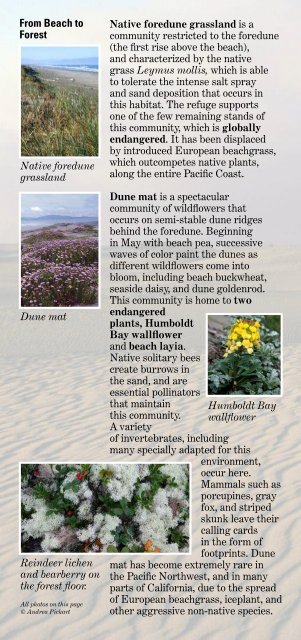Humboldt Bay - U.S. Fish and Wildlife Service
Humboldt Bay - U.S. Fish and Wildlife Service
Humboldt Bay - U.S. Fish and Wildlife Service
Create successful ePaper yourself
Turn your PDF publications into a flip-book with our unique Google optimized e-Paper software.
From Beach to<br />
Forest<br />
Native foredune<br />
grassl<strong>and</strong><br />
Dune mat<br />
Reindeer lichen<br />
<strong>and</strong> bearberry on<br />
the forest foor.<br />
All photos on this page<br />
© Andrea Pickart<br />
Native foredune grassl<strong>and</strong> is a<br />
community restricted to the foredune<br />
(the frst rise above the beach),<br />
<strong>and</strong> characterized by the native<br />
grass Leymus mollis, which is able<br />
to tolerate the intense salt spray<br />
<strong>and</strong> s<strong>and</strong> deposition that occurs in<br />
this habitat. The refuge supports<br />
one of the few remaining st<strong>and</strong>s of<br />
this community, which is globally<br />
endangered. It has been displaced<br />
by introduced European beachgrass,<br />
which outcompetes native plants,<br />
along the entire Pacifc Coast.<br />
Dune mat is a spectacular<br />
community of wildfowers that<br />
occurs on semi-stable dune ridges<br />
behind the foredune. Beginning<br />
in May with beach pea, successive<br />
waves of color paint the dunes as<br />
different wildfowers come into<br />
bloom, including beach buckwheat,<br />
seaside daisy, <strong>and</strong> dune goldenrod.<br />
This community is home to two<br />
endangered<br />
plants, <strong>Humboldt</strong><br />
<strong>Bay</strong> wallfower<br />
<strong>and</strong> beach layia.<br />
Native solitary bees<br />
create burrows in<br />
the s<strong>and</strong>, <strong>and</strong> are<br />
essential pollinators<br />
that maintain <strong>Humboldt</strong> <strong>Bay</strong><br />
this community. wallfower<br />
A variety<br />
of invertebrates, including<br />
many specially adapted for this<br />
environment,<br />
occur here.<br />
Mammals such as<br />
porcupines, gray<br />
fox, <strong>and</strong> striped<br />
skunk leave their<br />
calling cards<br />
in the form of<br />
footprints. Dune<br />
mat has become extremely rare in<br />
the Pacifc Northwest, <strong>and</strong> in many<br />
parts of California, due to the spread<br />
of European beachgrass, iceplant, <strong>and</strong><br />
other aggressive non-native species.<br />
Dune swales<br />
Moving dunes<br />
Coniferous dune<br />
forest<br />
Dune swales occur in the nearshore<br />
dunes in depressions between ridges.<br />
These seasonal freshwater wetl<strong>and</strong>s<br />
form in winter when loose s<strong>and</strong><br />
blows away <strong>and</strong> the water table rises,<br />
allowing plants to colonize. First<br />
algae, <strong>and</strong> then rushes <strong>and</strong> sedges<br />
occur with many associated herbs<br />
such as springbank clover, Pacifc<br />
silverweed, bird’s-foot trefoil, <strong>and</strong><br />
willow-herb. Soon, Hooker’s willow<br />
<strong>and</strong> beach pine follow, ultimately<br />
creating wooded swales that attract<br />
many birds <strong>and</strong> mammals. Swales<br />
provide the seasonal water needed for<br />
many amphibian species, including<br />
red-legged frogs <strong>and</strong> Pacifc tree<br />
frogs.<br />
Moving dunes are the most dramatic<br />
of the many l<strong>and</strong>forms found here.<br />
Large dunes migrate inl<strong>and</strong>, slowly<br />
covering the forest to the east. At the<br />
juncture of dune <strong>and</strong> forest, massive<br />
slipfaces slowly engulf trees that<br />
become bleached <strong>and</strong> skeletal as the<br />
dunes move forward. Few plants can<br />
gain a foothold here, but the constant<br />
traffc of mammals moving between<br />
forest <strong>and</strong> foraging areas on the<br />
dunes is recorded as an intricate maze<br />
of tracks.<br />
Coniferous dune forest occurs<br />
east of the moving dunes on older<br />
stabilized dunes. The dune forest is<br />
an incredibly lush <strong>and</strong> productive<br />
environment, with over 300 species<br />
of mushrooms, lichen, <strong>and</strong> mosses.<br />
The forest canopy is dominated by<br />
Sitka spruce <strong>and</strong> beach pine, with<br />
lesser gr<strong>and</strong> fr, Douglas-fr, <strong>and</strong><br />
madrone. The understory varies from<br />
dense st<strong>and</strong>s of huckleberry <strong>and</strong><br />
salal, to more open woodl<strong>and</strong>s with<br />
a groundcover of bearberry (ground<br />
manzanita), reindeer lichen, <strong>and</strong> the<br />
showy calypso orchid, rein orchid <strong>and</strong><br />
hooded ladies’ tresses. The largest<br />
mammals of the forest are gray fox,<br />
but there are many small mammals<br />
including the rare white-footed vole.

















